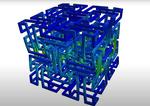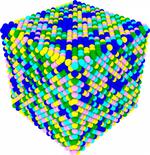Other
News Researchers use architected auxetics to achieve 300 times more flexibility in new 3D printing design

“There are young children celebrating the holidays this year with their families, thanks to the 3D-printed medical devices created in the lab of Georgia Tech researcher Scott Hollister. For more than 10 years, Hollister and his collaborators have developed lifesaving …
News Physicists at Georgia Tech and engineers at UC Santa Barbara are exploring the shallow underground world with a burrowing soft robot

“We’ve seen robots take to the air, dive beneath the waves and perform all sorts of maneuvers on land. Now, researchers at UC Santa Barbara and Georgia Institute of Technology are exploring a new frontier: the ground beneath our …

“Anyone with children knows that while controlling one child can be hard, controlling many at once can be nearly impossible. Getting swarms of robots to work collectively can be equally challenging, unless researchers carefully choreograph their interactions — like planes in …

“Individually, California blackworms live an unremarkable life eating microorganisms in ponds and serving as tropical fish food for aquarium enthusiasts. But together, tens, hundreds, or thousands of the centimeter-long creatures can collaborate to form a “worm blob,” a shape-shifting living …

“For environmental monitoring, precision agriculture, infrastructure maintenance and certain security applications, slow and energy efficient can be better than fast and always needing a recharge. That’s where “SlothBot” comes in. Powered by a pair of photovoltaic panels and designed …

“The rolling hills of Mars or the moon are a long way from the nearest tow truck. That’s why the next generation of exploration rovers will need to be good at climbing hills covered with loose material and avoiding …

“High-entropy alloys, which are made from nearly equal parts of several primary metals, could hold great potential for creating materials with superior mechanical properties. But with a practically unlimited number of possible combinations, one challenge for metallurgists is figuring out …

“The growing popularity of lithium-ion batteries in recent years has put a strain on the world’s supply of cobalt and nickel – two metals integral to current battery designs – and sent prices surging. In a bid to develop alternative designs …

“A wireless, wearable monitor built with stretchable electronics could allow comfortable, long-term health monitoring of adults, babies and small children without concern for skin injury or allergic reactions caused by conventional adhesive sensors with conductive gels. The soft and conformable …

“Researchers have created a new type of tiny 3D-printed robot that moves by harnessing vibration from piezoelectric actuators, ultrasound sources or even tiny speakers. Swarms of these “micro-bristle-bots” might work together to sense environmental changes, move materials – or perhaps one …

